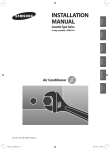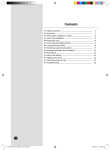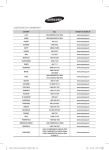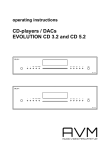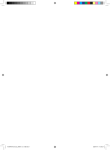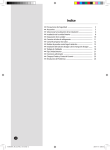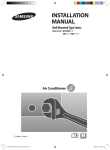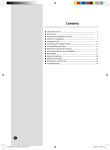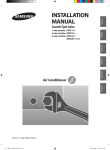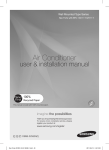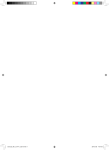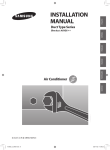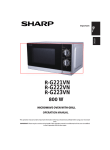Download Samsung AVXC4H045EE Installation manual
Transcript
ENGLISH
INSTALLATION
MANUAL
Cassette Type Series
DEUTSCH
Air Conditioner
PORTUGUÊS
ITALIANO
FRANÇAIS
ESPAÑOL
4 way cassette : AVXC4
E S F I P D DB98-27686A(1)
AVXC4_E_27686.indd 27
2007-4-20 15:48:45
Contents
■
■
■
■
■
■
■
■
■
■
■
■
■
■
Safety Precautions ............................................................................................................
Accessories ............................................................................................................................
Selecting the Installation Location .......................................................................
Indoor Unit Installation .................................................................................................
Purging the Unit ................................................................................................................
Connecting the Refrigerant Pipe ...........................................................................
Cutting/Flaring the Pipes .............................................................................................
Performing Leak Test & Insulation .........................................................................
Drainpipe and Drain Hose Installation ...............................................................
Wiring Work ...........................................................................................................................
Indoor Unit Setting .........................................................................................................
Additional Functions ......................................................................................................
Final Checks and User Tips ..........................................................................................
Troubleshooting ................................................................................................................
3
5
6
9
10
11
12
13
15
18
21
22
23
24
E-2
AVXC4_E_27686.indd 2
2007-4-20 15:48:18
Safety Precautions
ENGLISH
The following safety precautions must be taken when using your air conditioner.
WARNING
• Risk of electric shock can cause injury or death.
• Disconnect all remote electric power supplies before servicing,
installing or cleaning.
• Installation must be done by the manufacturer or service agent or a
similar qualified person in order to avoid a hazard.
INSTALLING THE UNIT
The unit should not be installed by the user. Ask the dealer or authorized company to install the units.
If the unit is installed improperly, water leakage, electric shock or fire may result.
Mount with the lowest moving parts at least 2.5 m above the floor or grade level. (If applicable)
The manufacturer does not assume responsibility for accidents or injury caused by an incorrectly installed
air conditioner. If you are unsure about installation, contact an installation specialist.
When installing the built-in type air conditioner, keep all electrical cables such as the power cable and the
connection cord in pipe, ducts, cable channels e.t.c to protect them against liquids, outside impacts and so on.
This appliance is not accessible to the general public. This appliance should be installed according to the
provided installation instruction.
When installing the air conditioner in a small room, the measure not to exceed the dangerous density is
needed.
- When refrigerant leaks and exceeds the dangerous density, suffocation may occur.
If any gas or impurities except R410A refrigerant come into the refrigerant pipe, serious problem may
occur and it may cause injury.
Use only rated accessories and install the air conditioner with rated equipments.
- If you dont’t use the rated accessories, the air conditioner may drop from its place, water may leak or
electric shock or fire may occur.
Ventilate your room when refrigerant gas leaks during installation.
- Toxic gas may generate when refrigerant gas contacts with heat.
POWER SUPPLY LINE OR CIRCUIT BREAKER
If the power cable of this air conditioner is damaged, it must be replaced by service agent or similarly
qualified persons in order to avoid a hazard.
The unit must be plugged into an independent circuit if applicable or connect the power cable to the
auxiliary circuit breaker. An all pole disconnection from the power supply must be incorporated in
the fixed wiring with a contact opening of >3mm.
The air conditioner must be installed in accordance with national wiring regulations and safety
regulations wherever applicable.
The electric work must be done by service agent or similarly qualified persons according to national
wiring regulations and use only rated cable.
- If the capacity of the power cable is insufficient or electric work is not properly completed,
electric shock or fire may occur.
Install the cables with supplied cables firmly. Fix them securely so that external force is not exerted to the
terminal board.
- If the connection or fixing is incomplete, heat generation, electric shock or fire may occur.
Connect the power cable between the indoor and outdoor unit properly so that the electrical
component box cover is not get loosen and attach the cover securely.
- If the the cover is attached incompletely, heat generation, electric shock or fire of the terminal
board may occur.
E-3
AVXC4_E_27686.indd 3
2007-4-20 15:48:18
Safety Precautions (Continued)
CAUTION
Make sure that you earth the cables.
- Do not connect the earth wire to the gas pipe, water pipe, lighting
rod or telephone wire. If earthing is not complete, electric shock or
fire may occur.
Install the circuit breaker.
- If the circuit breaker is not installed, electric shock or fire may occur.
Make sure that the condensed water dripping from the drain hose
runs out properly and safely.
Install the power cable and communication cable of the indoor and
outdoor unit at least 1m away from the electric appliance.
Install the indoor unit away from lighting apparatus using the ballast.
- If you use the wireless remote control, reception error may occur
due to the ballast of the lighting apparatus.
Do not install the air conditioner in following places.
- Place where there is mineral oil or arsenic acid
Resin parts flame and the accessories may drop or water may leak.
The capacity of the heat exchanger may reduce or the air conditioner
may be out of order.
- The place where corrosive gas such as sulfurous acid gas generates
from the vent pipe or air outlet
The copper pipe or connection pipe may corrode and refrigerant
may leak.
- The place where there is a machine that generates electromagnetic
waves
The air conditioner may not operate normally due to control
system.
- The place where there is a danger of existing combustible gas,
carbon fiber or flammable dust
The place where thinner or gasoline is handled
Gas may leak and it may cause fire.
E-4
AVXC4_E_27686.indd 4
2007-4-20 15:48:18
Accessories
ENGLISH
The following accessories are supplied with the indoor unit.
The type and quantity may differ depending on the specifications.
Pattern sheet
Insulation cover drain
Insulation
Insulation cover band
Insulation pipe
Insulation drain hose
Cable-tie
Flexible hose
M4x12 tapped Screw
Insulation drain sub
Pad stopper
User’s Manual
Installation manual
Safety net
M4x12 tapped Screw
E-5
AVXC4_E_27686.indd 5
2007-4-20 15:48:19
Selecting the Installation Location
Indoor Unit
There must be no obstacles near the air inlet and outlet.
Install the indoor unit on a ceiling that can support its weight.
Maintain sufficient clearance around the indoor unit.
Make sure that the water dripping from the drain hose runs away
correctly and safely.
The indoor unit must be installed in this way, that they are out of public
access. (Not touchable by the users)
Rigid wall without vibration.
Where it is not exposed to direct sunshine.
Where the air filter can be removed and cleaned easily.
Space Requirements for Indoor Unit
ore
m or m
1500m
15
00
m
m
or
m
or
e
15
00
m
m
or
m
or
e
ore
m or m
1500m
E-6
AVXC4_E_27686.indd 6
2007-4-20 15:48:20
ENGLISH
Dimension of the indoor unit
AVXC4045/056/071/090
Unit : mm
860-690 (Ceiling opening)
950
766 (Suspension position)
178 Adjustable
950
57
57
840
260
290
25
No.
242
246
305
Name
Branch duct
connection
1000mm
322
or more
Required space
208
100
80
230
160
190
41
64
218
166
344
25
860-690 (Ceiling opening)
699 (Suspension position)
Description
1
Liquid pipe connection
045/056ø6.35 (1/4”)
071/090ø9.52 (3/8”)
2
Gas pipe connection
045/056ø12.70 (1/2”)
071/090ø15.88 (5/8”)
3
Drain pipe connection
VP20 (OD ø26, ID ø20)
E-7
AVXC4_E_27686.indd 7
2007-4-20 15:48:21
Selecting the Installation Location (Continued)
AVXC4090/112/128/140
Unit : mm
5
6
57
310
840
260
290
25
57
322
242
246
305
4
No.
1
1000 or more
64
160
190
200
25
208
57
840
158
138
68
258 Adjustable
3
41
298
457
57
2
Name
Description
1
Liquid pipe connection
ø9.52 (3/8”)
2
Gas pipe connection
ø15.88 (5/8”)
3
Drain pipe connection
VP25 (OD ø32, ID ø25)
E-8
AVXC4_E_27686.indd 8
2007-4-20 15:48:24
ENGLISH
Indoor Unit Installation
It is recommended to install the Y- joint before installing the indoor unit.
1
Place the pattern sheet on the ceiling at the spot where you want to
install the indoor unit.
Since the diagram is made of paper, it may shrink or stretch
slightly due to temperature or humidity. For this reason,
before drilling the holes maintain the correct dimensions
between the markings.
2
Concrete
Insert bolt anchors, use existing ceiling supports or construct a suitable
support as shown in figure.
Insert
Hole in anchor
Hole in plug
Suspension bolt(3/8" or M10)
3
Ceiling support
Install the suspension bolts depending on the ceiling type.
Ensure that the ceiling is strong enough to support
the weight of the indoor unit. Before hanging the unit,
test the strength of each attached suspension bolt.
If the length of suspension bolt is more than 1.5m,
it is required to prevent vibration.
4
Nut
Screw eight nuts to the suspension bolts making space for hanging the
indoor unit.
You must install the suspension bolts more than four when
installing the indoor unit.
Washer
Rubber
Fasten the nut
5
Check the level of the indoor unit by using a leveler.
A tilt of the indoor unit may cause malfunction of a built-in float switch
and water leaks.
Level
6
Adjust the height of the indoor unit by using the gauge of dimensions.
You should adjust the gauge of dimensions and the pattern sheet to fit
the cutting dimensions of ceiling.
Make sure that the indoor unit is installed at a level if the indoor unit
slants too much, there can be water leaks.
Indoor Unit
20mm
Ceiling
35mm
7
Tighten the upper part nuts.
8
Remove the gauge of dimensions after installing the indoor unit.
Gauge of
Dimensions
E-9
AVXC4_E_27686.indd 9
2007-4-20 15:48:30
Purging the Unit
On delivery, the indoor unit is loaded with inert gas.
All this gas must therefore be purged before connecting the assembly piping.
To purge the inert gas, proceed as follows.
Unscrew the pinch pipe at the end of each refrigerant pipe.
Gas refrigerant
port
Result:
All inert gas escapes from the indoor unit.
Note
To prevent dirt or foreign objects from getting into the pipes
during installation, do NOT remove the pinch pipe completely
until you are ready to connect the piping.
Liquid refrigerant port
The designs and shape are subject to
change according to the model.
E-10
AVXC4_E_27686.indd 10
2007-4-20 15:48:31
ENGLISH
Connecting the Refrigerant Pipe
There are two refrigerant pipes of differing diameters:
A smaller one for the liquid refrigerant
A larger one for the gas refrigerant
The inside of copper pipe must be clean & has no dust.
1
Before connecting the reprigerant pipe, open the cover side.
2
Remove the pinch pipe on the pipes and connect the assembly pipes to each
pipe, tightening the nuts, first manually and then with a torque wrench,
a spanner applying the following torque.
Outer Diameter
6.35 mm (1/4")
9.52 mm (3/8")
12.70 mm (1/2")
15.88 mm (5/8")
Note
3
Torque (kgf•cm)
145~175
333~407
505~615
630~769
Refrigerant oil
Torque wrench
Spanner
Flare nut
Union
Must apply refrigerant oil on the flaring area to prevent
a leak.
Be sure that there must be no crack or kink on the bended area.
Cover side
The designs and shape are subject to
change according to the model.
E-11
AVXC4_E_27686.indd 11
2007-4-20 15:48:31
Cutting/Flaring the Pipes
1
Make sure that you prepared the required tools.
(pipe cutter, reamer, flaring tool and pipe holder)
2
If you want to shorten the pipe, cut it using a pipe cutter ensuring that the cut
edge remains at 90° with the side of the pipe. There are some
examples of correctly and incorrectly cut edges below.
O
Oblique
Rough
X
X
Burr
X
3
To prevent a gas leak, remove all burrs at the cut edge of the pipe using
a reamer.
4
Carry out flaring work using flaring tool as shown below.
A
Flaring tool
York
Die
Die
Clutch type
Outer diameter
(mm)
Wing nut type
Flare tool for
R410A clutch type
0~0.5
0~0.5
0~0.5
0~0.5
Conventional flare tool
Clutch type
Wing nut type
1.0~1.5
1.5~2.0
1.0~1.5
1.5~2.0
1.0~1.5
1.5~2.0
1.0~1.5
1.5~2.0
Check if you flared the pipe correctly. There are some examples of
incorrectly flared pipes below.
X
X
X
X
Inclined
Damaged Surface
Cracked
Uneven Thickness
Outer diameter
Connection
Flare dimension
(mm)
Torque(kgf•cm)
(mm)
145~175
8.70~9.10
333~407
12.80~13.20
12.70
505~615
16.20~16.60
15.88
630~769
19.30~19.70
45° ± 2°
6.35
9.52
Flare shape
90° ±2°
6
Flare nut
A(mm)
6.35
9.52
12.70
15.88
5
Copper pipe
Copper pipe
R 0.4~0.8
CAUTION
In case of needing brazing, you must work with Nitrogen gas blowing.
E-12
AVXC4_E_27686.indd 12
2007-4-20 15:48:32
ENGLISH
Performing Leak Test & Insulation
Leak Test
To check for gas leaks on the indoor unit, check the connection part of each
refrigerant pipe by using Nitrogen gas.
Note
See detail on outdoor unit installiation mannal for leak test.
Leak check
The designs and shape are subject to
change according to the model.
Insulation
Once you have checked that there are no leaks in the system, you can
insulate the piping and hose.
1
Insulate the refrigerant pipe.
Clamp
Insulation
Be sure to insulate the refrigerant pipe, joint and connection part.
-If you insulate the pipes, the condensed water does not fall from the
pipes and the capacity of the air conditioner is improved.
Check if there are any insulation cracks on the bent pipe.
Insulation
Gas side pipe
Liquid side pipe
Insulation
Indoor unit
Install the insulation
to be overlapped
Fix it not to be get wider
E-13
AVXC4_E_27686.indd 13
2007-4-20 15:48:33
Performing Leak Test & Insulation (Continued)
2
Select the insulation of the refrigerant pipe.
Insulate the gas side and liquid side pipe referring to the thickness
according to the pipe size.
The thickness according to the pipe size is a standard of the indoor
temperature of 27°C and humidity of 80%.
If installing in an unfavorable conditions, use thicker one.
Insulator’s heat-resistance temperature should be more than 120℃.
Pipe size
(mm)
Minimum thickness
of insulation (mm)
PE foam
EPDM foam
Ø6.35~Ø15.88
13
10
-
25
19
Remarks
If you install the pipe underground,
at the seaside, a spa or on the lake,
use 1 grade thicker one according
to the pipe size.
Refrigerant pipe before EEV kit and MCU or without EEV kit and MCU
Insulation
Insulation
You can contact the gas side and liquid side pipes but the pipes
should not be pressed.
When contacting the gas side and gas side pipe, use 1 grade thicker
Liquid pipe
Gas pipe
insulator.
Refrigerant pipe after EEV kit and MCU
Install the gas side and liquid side pipes, leave 10mm of space.
10mm
10mm
10mm
10mm
When contacting the gas side and liquid side pipe, use 1 grade
thicker insulator.
CAUTION
Gas pipe
Liquid pipe
Install the insulation not to get wider and use the adhesives
on the connection part of it to prevent moisture from entering.
Wind the refrigerant pipe with insulation tape if it is exposed to
outside sunlight.
Install the refrigerant pipe respecting that the insulation does not
get thinner on the bent part or hanger of pipe.
Add the additional insulation if the insulation plate gets thinner.
Hanger
Additional insulation
a
a×3
Refrigerant pipe insulation
E-14
AVXC4_E_27686.indd 14
2007-4-20 15:48:34
ENGLISH
Drain pipe and Drain Hose Installation
Care must be taken when installing the drainpipe and drain hose for the indoor unit so
that condensate water is drained correctly outside.
1
Fix the flexible hose to the drainpipe.
The connection port of the flexible hose and PVC drainpipe must be fixed
with PVC adhesives.
Flexible hose
Drainpipe
Check out that the connected part doesn’t leak.
Drain pipe type : VP25
2
Connect the flexible hose to the drain hose port.
Make sure that a rubber ring is installed on the drain hose port.
Drain hose port location differs depending on the unit types.
3
Insulation cover band
Insulation drainpipe
Install the drain pipe as shortly as possible.
Give a slightly slant to the drainpipe for proper drainage of condensate
water.
There must be no gap on the connected part so that the drainpipe is
not separated from the flexible hose.
4
Drain hose port
Insulate the drainpipe, and then fix it as indicated.
Insulation cover drain
Indoor
Unit
Band(Not supplied)
Drain
hose
port
Whole drainpipe should be insulated by 5t(or more) insulation to prevent
water condensation.
Adhesives
Flexible
hose
Band
Drainpipe
Band
E-15
AVXC4_E_27686.indd 15
2007-4-20 15:48:35
Drain pipe and Drain Hose Installation (Continued)
Drainpipe Connection
1
The drain pipe should be installed within 100mm from the flexible hose,
lift up from 100mm to 550mm and lift down 20mm or more.
2
Install horizontal drainpipe with a slope of 1/100 or more and fix it by hanger
space of 1.0~1.5m.
3
Install the air vent in the horizontal drainpipe to prevent water flow back to
the indoor unit.
Be horizontal
Indoor
Unit
Flexible hose
Note
Flexible hose Installation
Indoor
Unit
You may not need to install it if there were proper slope in the
horizontal drainpipe.
4
The flexible hose should not be installed upward position, it may cause
water flow back to the indoor unit.
5
Install U-trap at the end of the drainpipe to prevent a nasty smell to reach
the indoor unit.
Max. 20mm
Max. allowable axis gap
1~1.5m
Air vent
300mm or less
Flexible hose
Indoor
Unit
100mm
or more
100~550mm
or more
Max. 30˚
Hanger
Horizontal drainpipe
more than 1/100 slope
Ceiling
Max. allowable bending angle
Centralized Drainage
Insulation
Connect to
indoor unit
Insulation
flexible hose
(Apply adhesive on
the outside)
PVC
drain pipe
PVC
drain pipe
(Apply
adhesive on
the inside)
1
Install main air vent at the front of the farthest indoor unit from the main
drain when installed indoor units are more than 3.
2
You may need to install individual air vent to prevent water flow back at the
top of each indoor unit drainpipe.
Handle with using adhesive not to block
inside of flexible hose
1~1.5m
Hanger
Main air vent
Individual
air vent
550mm or less
Main drainpipe
Centralized horizontal drainpipe
(more than 1/100 slope)
E-16
AVXC4_E_27686.indd 16
2007-4-20 15:48:36
ENGLISH
Testing the Drainage
You should test drainage after completing the installation.
Prepare a little water about 1.0 liter.
1
Open the cover water supply intake.
2
Pour water into the water supply intake.
3
Operate the unit in the Cool mode and check a drain pump pumping.
4
Check drain water drops at the end of the drainpipe.
Cover drain pump
Drainpipe
Drain water drops
5
Make sure there is no water leak at the drainage.
6
When you finished the test, close the coverside.
CAUTION
When maintaining the air conditioner, remove condensate water
remained in the drain pan by using a drain port for maintenance.
or less
E-17
AVXC4_E_27686.indd 17
2007-4-20 15:48:37
Wiring Work
Power and communication cable connection
1
Before wiring work, you must turn off all power source.
2
Indoor unit power should be supplied through the breaker(MCCB, ELB) separated by the outdoor power.
3
The power cable should be used only copper wires.
4
Connect the power cable{1(L), 2(N)} among the units within maximum length and communication cable(F1, F2) each.
5
Connect V1, V2(for DC12V) and F3, F4(for communication) when installing the wired remote controller.
Outdoor Unit
Wired Remote
Controller
220-240V~
L
Indoor Unit 2
EEV kit
N
Indoor Unit 1
Indoor Unit 3
N
L
N
L
N
L
ELB : Essential Installation
Indoor Unit 4
Indoor Unit 5
Indoor Unit 6
Ceiling, wall-mounted indoor unit.
Selecting compressed ring terminal
Silver solder
B
D
d1
E
F
L
d2
t
Norminal
Norminal
Standard
Standard
Standard
Standard
dimensions for dimensions for
Allowance
Allowance
Allowance
Allowance
Min. Min. Max. dimension
Min.
dimension
dimension
dimension
cable (mm2)
screw (mm)
(mm)
(mm)
(mm)
(mm)
(mm)
(mm)
(mm)
(mm)
1.5
2.5
4
4
4
4
4
6.6
8
6.6
8.5
4
9.5
±0.2
3.4
±0.2
4.2
±0.2
5.6
+0.3
-0.2
+0.3
-0.2
+0.3
-0.2
1.7
±0.2
4.1
6
16
4.3
2.3
±0.2
6
6
17.5
4.3
3.4
±0.2
6
5
20
4.3
+0.2
0
+0.2
0
+0.2
0
0.7
0.8
0.9
E-18
AVXC4_E_27686.indd 18
2007-4-20 15:48:38
ENGLISH
Specification of electronic wire
Power supply
MCCB
ELB
Max : 242V
Min : 198V
XA
X A, 30mmA
0.1 sec
Communication
cable
Power cable Earth cable
2.5mm2
2.5mm2
0.75~1.5mm2
Decide the capacity of ELB and MCCB by below formula.
Rating current
Unit
Model
Rating current
AVXC4
045
056
071
090
112
128
140
0.19A
0.19A
0.21A
0.23A
0.23A
0.30A
0.36A
The capacity of ELB, MCCB X [A] = 1.25 X 1.1 X ∑Ai
X : The capacity of ELB, MCCB
∑Ai : Sum of Rating currents of each indoor unit.
Refer to each installation manual about the rating current of indoor unit.
Decide the power cable specification and maximum
length within 10% power drop among indoor units.
Coef×35.6×Lk×ik
n
∑(
1000×Ak
k=1
)<
10% of input
voltage[V]
coef: 1.55
Lk : Distance among each indoor unit[m], Ak: Power cable specification[mm2]
ik : Running current of each unit[A]
Example of Installation
- Total power cable length L = 100(m), Running current of each units 1[A]
- Total 10 indoor units were installed
10[A]
ELB
9[A]
1[A]
MCCB
Indoor unit1
0[m]
Indoor unit10
Indoor unit2
10[m]
20[m]
100[m]
Apply following equation.
Coef×35.6×Lk×ik
n
∑(
1000×Ak
k=1
)<
10% of input
voltage[V]
Calculation
Installing
with 1 sort wire.
2.5[mm2]
2.5[mm2]
-2.2[V]
-2.0[V]
220[V]
208.8[V](Within 198V~242V)
it's okay
-(2.2+2.0+1.8+1.5+1.3+1.1+0.9+0.7+0.4+0.2)=-11.2[V]
Installing
with 2 different sort wire.
4.0[mm2]
220[V]
············ 2.5[mm2] ············
-1.4[V]
4.0[mm2]
············ 2.5[mm2] ············
-1.2[V]
-(1.4+1.2+1.8+1.5+1.3+1.1+0.9+0.7+0.4+0.2)=-10.5[V]
209.5[V](Within 198V~242V)
it's okay
E-19
AVXC4_E_27686.indd 19
2007-4-20 15:48:39
Wiring Work (Continued)
CAUTION
Select the power cable in accordance with relevant local and national
regulations.
Wire size must comply with local and national code.
For the power cable, use the grade of H07RN-F or H05RN-F materials.
You should connect the power cable into the power cable terminal
and fasten it with a clamp.
The unbalanced power must be maintained within 10% of supply
rating among whole indoor units.
If the power is unbalanced greatly, it may shorten the life of the
condenser. If the unbalanced power is exceeded over 10% of supply
rating, the indoor unit is protected, stopped and the error mode
indicates.
To protect the product from water and possible shock, you should keep
the power cable and the connection cord of the indoor and outdoor
units in the iron pipe.
Connect the power cable to the auxiliary circuit breaker.
An all pole disconnection from the power supply must be incorporated
in the fixed wiring(≥3mm).
You must keep the cable in a protection tube.
Keep distances of 50mm or more between power cable and
communication cable.
Maximum length of power cables are decided within 10% of power
drop. If it exceeds, you must consider another power supplying
method.
The circuit breaker(MCCB, ELB) should be considered more capacity
if many indoor units are connected from one breaker.
Use round pressure terminal for connections to the power terminal
block.
For wiring, use the designated power cable and connect it firmly,
then secure to prevent outside pressure being exerted on the terminal
board.
Use an appropriate screwdriver for tightening the terminal screws.
A screwdriver with a small head will strip the head and make proper
tightening impossible.
Over-tightening the terminal screws may break them.
See the table below for tightening torque for the terminal screws.
Tightening torque(kgf•cm)
M4
12.0~14.7
E-20
AVXC4_E_27686.indd 20
2007-4-20 15:48:39
ENGLISH
Indoor Unit Setting
Main Address Setting
1
Before installing the indoor unit, assign an address to the indoor unit
according to the air conditioning system plan.
2
The address of the indoor unit is assigned by adjusting MAIN(SW01, SW02) and
RMC(SW03, SW04) rotary switches.
SW01
SW02
K1 K2 K3 K4
SW03
K5 K6 K7 K8
SW04
K9K10K11K12
The designs and shape are subject to change according to the model.
Setting Main Address
The MAIN address is for communication between the indoor unit and the
outdoor unit. Therefore, you must set it to operate the air conditioner
properly.
You can set the MAIN address from ‘00’ to ‘99’ by mixing SW01 and SW02.
The MAIN address from ‘00’ to ‘99’ should differ from each other.
Check the indoor unit address on the plan that you are to install and set
the address according to the plan.
Note
You may not need to set main address if you selected Auto
Address Setting from the outdoor unit: see details on the outdoor
unit installation manual.
For Example
When Main address is set as "12".
Setting RMC Address
You must set the SW03, SW04 and K2 switch when using the centralized controller.
For Example
When RMC address is set as "12".
SW03
SW04
E-21
AVXC4_E_27686.indd 21
2007-4-20 15:48:41
Additional Functions
No.
SW05
K1 K2 K3 K4
Function
ON
OFF
K1
Wired remote control
-
-
K2
Centralized control
Not use
Use
K3
RPM up
Normal
up
K4
Option drain pump
N/A
N/A
N/A : Not Available
No.
SW06
K5 K6 K7 K8
Function
ON
OFF
K5
Heating thermo-off
+5°C
+2°C
K6
Filter signal display
1,000 hours
2,000 hours
K7
Hot water coil
N/A
N/A
K8
Electrical heater
Not use
Use
N/A : Not Available
No.
SW07
K9K10K11K12
Function
ON
OFF
K9
Min. EEV step at heating
Fix 80 step
0 or 80 step
K10
Transmitter grouping
N/A
N/A
K11
External control
Not Use
Use
K12
Spare
-
-
N/A : Not Available
E-22
AVXC4_E_27686.indd 22
2007-4-20 15:48:42
ENGLISH
Final Checks and User Tips
To complete the installation, perform the following checks and tests to ensure
that the air conditioner operates correctly.
1
Check the following.
Strength of the installation site
Tightness of pipe connection to detect a gas leak
Electric wiring connections
Heat-resistant insulation of the pipe
Drainage
Earth conductor connection
Correct operation (follow the steps below)
After finishing the installation of the air conditioner, you should explain the
following to the user. Refer to appropriate pages in the User’s Manual.
1
How to start and stop the air conditioner
2
How to select the modes and functions
3
How to adjust the temperature and fan speed
4
How to adjust the airflow direction
5
How to set the timers
6
How to clean and replace the filters
rs
Note
When you complete the installation successfully, hand over
the User’s Manual and this Installation Manual to the user for
storage in a handy and safe place.
E-23
AVXC4_E_27686.indd 23
2007-4-20 15:48:43
Troubleshooting
Detection of errors
If an error occurs during the operation, one or more LED flickers and the operation is stopped except the LED.
If you re-operate the air conditioner, it operates normally at first, then detect an error again.
LED Display on the receiver & display unit
LED Display
Indicators
Abnormal conditions
Operating
Green
Red
X
Power reset
Error of temperature sensor in indoor unit
(OPEN/SHORT)
X
Error of heat exchanger sensor in indoor unit
Error of heat exchanger OUT sensor in indoor unit
Error of outlet temperature sensor in indoor unit
(OPEN/SHORT): For heat pump models only
Error of indoor fan motor:
Below 450RPM for 15 minutes
X
X
X
X
Error of outdoor temperature sensor
Error of COND sensor
Error of DISCHARGE sensor
X
X
X
X
X
X
Displayed on appropriate indoor unit
which is operating
Displayed on appropriate indoor unit
which is operating
X
X
X
Displayed on appropriate indoor unit
which is operating
X
X
X
Displayed on appropriate indoor unit
which is operating
Displayed on outdoor unit
1. No communication for 2 minutes between
indoor unit and outdoor unit (communication
error for more than 2 minutes)
1. Error of indoor unit: Displayed on the
indoor unit regardless of operation
2. Indoor unit receiving the communication
error from outdoor unit
2. Error of outdoor unit: Displayed on the
indoor unit which is operating
3. Outdoor unit tracking 3 minute error
X
X
X
4. When sending the communication
error from outdoor unit due to the
mismatching of the communication
numbers and installed numbers after
completion of tracking (communication
error for more than 2 minutes)
● On
Flickering X Off
If you turn off the air conditioner when the LED is flickering, the LED is also turned off.
If you re-operate the air conditioner, it operates normally at first, then detects an error again.
E-24
AVXC4_E_27686.indd 24
2007-4-20 15:48:43
ENGLISH
LED Display
Indicators
Abnormal conditions
Operating
Green
Red
Self-diagnostic error
(including the indoor unit not detected)
1. Error of electronic expansion valve close
2. Error of electronic expansion valve open
X
X
Displayed on appropriate indoor unit
which is operating
Displayed on outdoor unit
X
3. Breakaway of EVA OUT sensor
4. Breakaway of EVA IN sensor
Displayed on appropriate indoor unit
which is operating
Displayed on outdoor unit
5. Breakaway of COND MID sensor
6. 2nd detection of refrigerant completely leak
7. 2nd detection of high temperature COND
8. 2nd detection of high temperature DISCHARGE
9. COMP DOWN due to 2nd detection of
low pressure switch
X
X
Detection of the float switch
X
X
Error of setting option switches for optional
accessories
X
X
10. Error of reverse phase
11. Compressor down due to 6th detection of
freezing
12. Self-diagnosis of condensation sensor (G8, G9)
13. Compressor down due to condensation
ratio control
X
EEPROM error
X
X
X
EEPROM option error
● On
Flickering X Off
If you turn off the air conditioner when the LED is flickering, the LED is also turned off.
If you re-operate the air conditioner, it operates normally at first, then detects an error again.
E-25
AVXC4_E_27686.indd 25
2007-4-20 15:48:44
AVXC4_E_27686.indd 26
2007-4-20 15:48:45


























